Corporate, Retail, and Financial Markets: Banking and Finance Concepts
VerifiedAdded on 2020/11/02
|16
|4605
|44
Homework Assignment
AI Summary
This document provides a comprehensive overview of various banking and finance concepts. It covers topics such as corporate and retail banking, including services like wholesale banking, lifeline banking, and chattel mortgages. The document also delves into financial instruments like self-liquidating loans, hybrid accounts, and factoring. Furthermore, it explores financial markets and institutions, discussing topics like OTC markets, liquidity premium theory, the Fisher effect, investment-grade bonds, and the crowding-out effect. Quantitative analysis, including naive models, decision trees, and forecast errors, is also addressed. Additionally, the document touches upon organizational behavior and human resource management, exploring topics like employee management, job satisfaction, charismatic leadership, and restructuring. The legal environment of banks and insurance, along with security analysis and portfolio management, is also covered, including topics like risk neutrality, beta, and the security market line. The document provides definitions and explanations of these concepts, making it a valuable resource for students studying banking and finance.
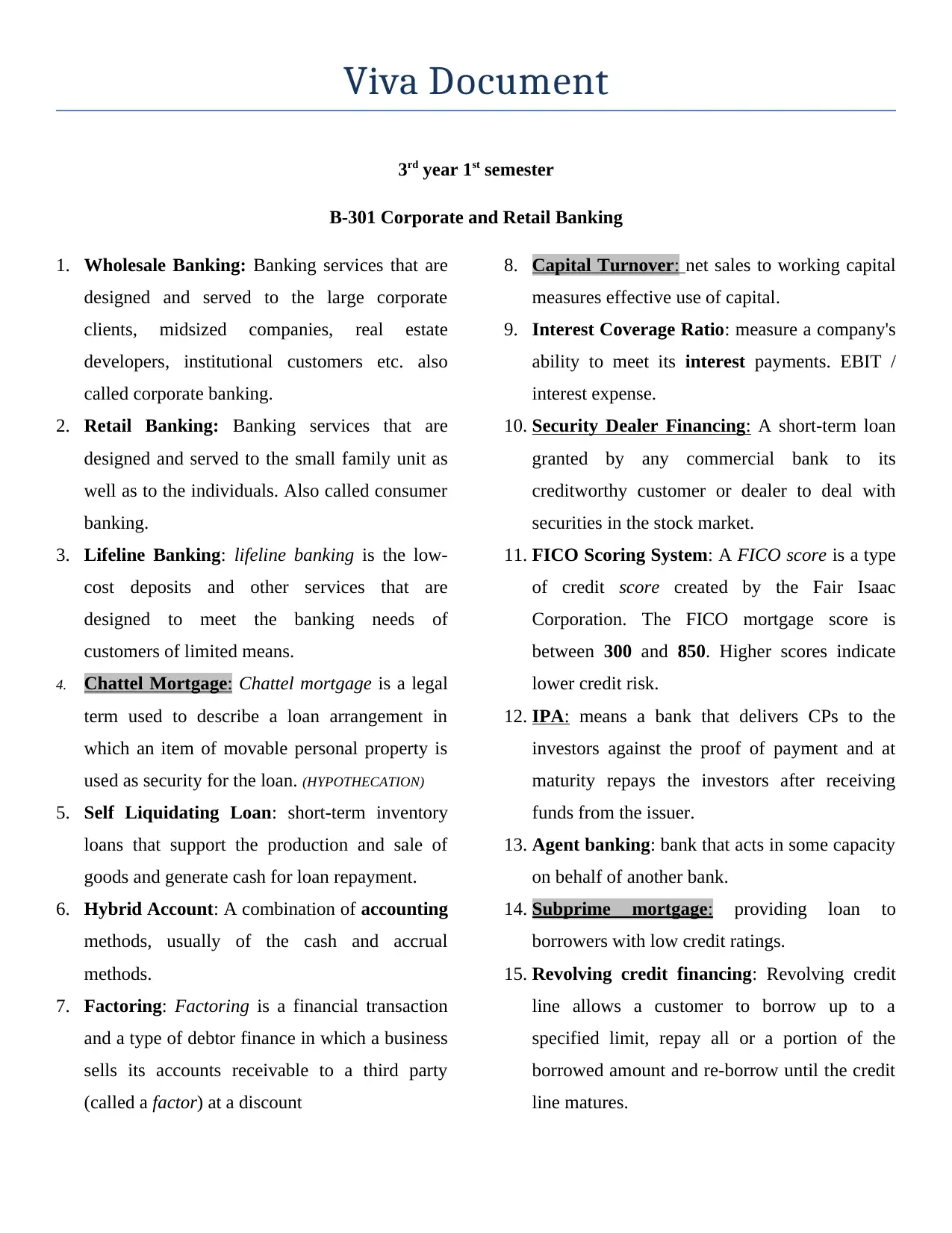
Viva Document
3rd year 1st semester
B-301 Corporate and Retail Banking
1. Wholesale Banking: Banking services that are
designed and served to the large corporate
clients, midsized companies, real estate
developers, institutional customers etc. also
called corporate banking.
2. Retail Banking: Banking services that are
designed and served to the small family unit as
well as to the individuals. Also called consumer
banking.
3. Lifeline Banking: lifeline banking is the low-
cost deposits and other services that are
designed to meet the banking needs of
customers of limited means.
4. Chattel Mortgage: Chattel mortgage is a legal
term used to describe a loan arrangement in
which an item of movable personal property is
used as security for the loan. (HYPOTHECATION)
5. Self Liquidating Loan: short-term inventory
loans that support the production and sale of
goods and generate cash for loan repayment.
6. Hybrid Account: A combination of accounting
methods, usually of the cash and accrual
methods.
7. Factoring: Factoring is a financial transaction
and a type of debtor finance in which a business
sells its accounts receivable to a third party
(called a factor) at a discount
8. Capital Turnover: net sales to working capital
measures effective use of capital.
9. Interest Coverage Ratio: measure a company's
ability to meet its interest payments. EBIT /
interest expense.
10. Security Dealer Financing: A short-term loan
granted by any commercial bank to its
creditworthy customer or dealer to deal with
securities in the stock market.
11. FICO Scoring System: A FICO score is a type
of credit score created by the Fair Isaac
Corporation. The FICO mortgage score is
between 300 and 850. Higher scores indicate
lower credit risk.
12. IPA: means a bank that delivers CPs to the
investors against the proof of payment and at
maturity repays the investors after receiving
funds from the issuer.
13. Agent banking: bank that acts in some capacity
on behalf of another bank.
14. Subprime mortgage: providing loan to
borrowers with low credit ratings.
15. Revolving credit financing: Revolving credit
line allows a customer to borrow up to a
specified limit, repay all or a portion of the
borrowed amount and re-borrow until the credit
line matures.
3rd year 1st semester
B-301 Corporate and Retail Banking
1. Wholesale Banking: Banking services that are
designed and served to the large corporate
clients, midsized companies, real estate
developers, institutional customers etc. also
called corporate banking.
2. Retail Banking: Banking services that are
designed and served to the small family unit as
well as to the individuals. Also called consumer
banking.
3. Lifeline Banking: lifeline banking is the low-
cost deposits and other services that are
designed to meet the banking needs of
customers of limited means.
4. Chattel Mortgage: Chattel mortgage is a legal
term used to describe a loan arrangement in
which an item of movable personal property is
used as security for the loan. (HYPOTHECATION)
5. Self Liquidating Loan: short-term inventory
loans that support the production and sale of
goods and generate cash for loan repayment.
6. Hybrid Account: A combination of accounting
methods, usually of the cash and accrual
methods.
7. Factoring: Factoring is a financial transaction
and a type of debtor finance in which a business
sells its accounts receivable to a third party
(called a factor) at a discount
8. Capital Turnover: net sales to working capital
measures effective use of capital.
9. Interest Coverage Ratio: measure a company's
ability to meet its interest payments. EBIT /
interest expense.
10. Security Dealer Financing: A short-term loan
granted by any commercial bank to its
creditworthy customer or dealer to deal with
securities in the stock market.
11. FICO Scoring System: A FICO score is a type
of credit score created by the Fair Isaac
Corporation. The FICO mortgage score is
between 300 and 850. Higher scores indicate
lower credit risk.
12. IPA: means a bank that delivers CPs to the
investors against the proof of payment and at
maturity repays the investors after receiving
funds from the issuer.
13. Agent banking: bank that acts in some capacity
on behalf of another bank.
14. Subprime mortgage: providing loan to
borrowers with low credit ratings.
15. Revolving credit financing: Revolving credit
line allows a customer to borrow up to a
specified limit, repay all or a portion of the
borrowed amount and re-borrow until the credit
line matures.
Paraphrase This Document
Need a fresh take? Get an instant paraphrase of this document with our AI Paraphraser
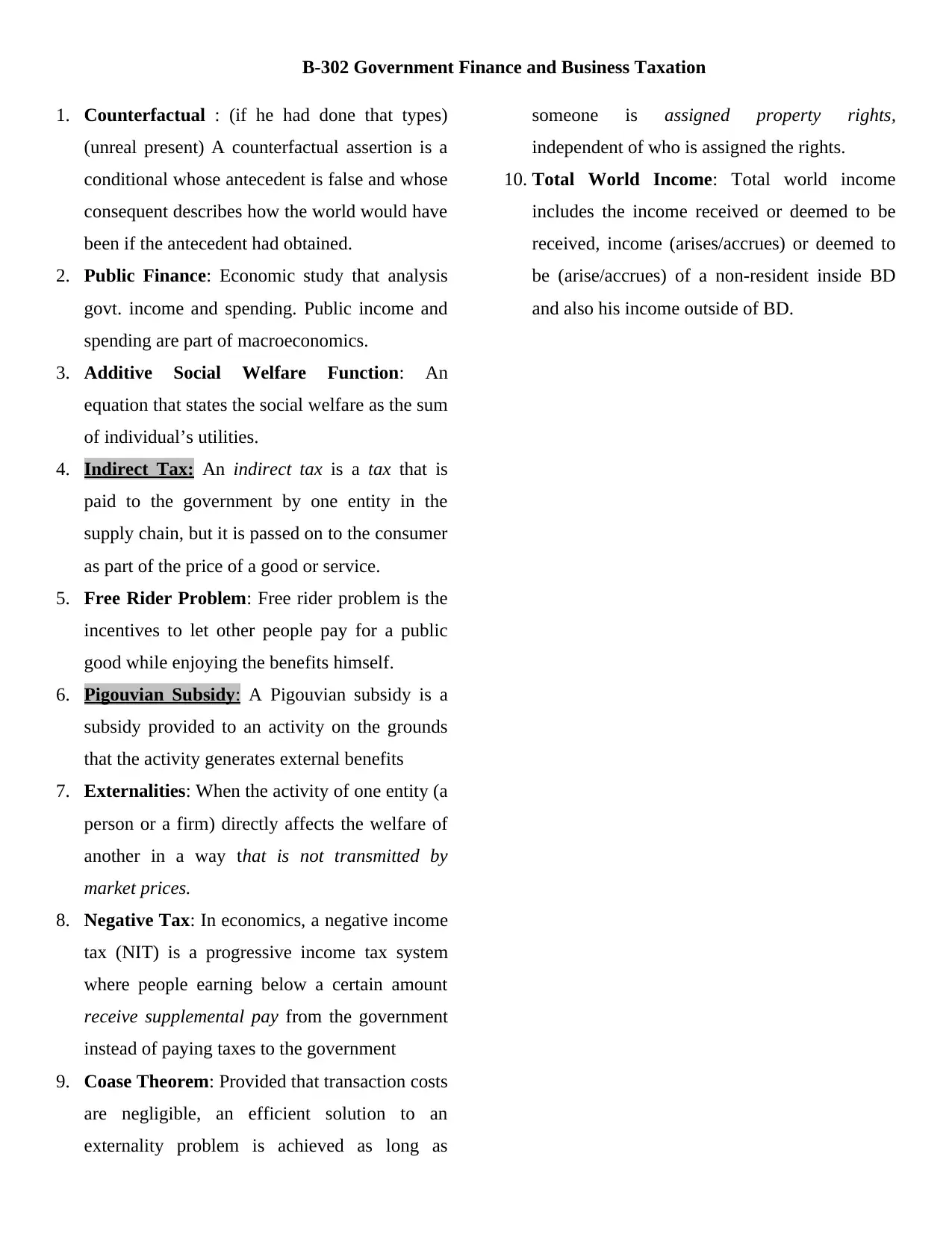
B-302 Government Finance and Business Taxation
1. Counterfactual : (if he had done that types)
(unreal present) A counterfactual assertion is a
conditional whose antecedent is false and whose
consequent describes how the world would have
been if the antecedent had obtained.
2. Public Finance: Economic study that analysis
govt. income and spending. Public income and
spending are part of macroeconomics.
3. Additive Social Welfare Function: An
equation that states the social welfare as the sum
of individual’s utilities.
4. Indirect Tax: An indirect tax is a tax that is
paid to the government by one entity in the
supply chain, but it is passed on to the consumer
as part of the price of a good or service.
5. Free Rider Problem: Free rider problem is the
incentives to let other people pay for a public
good while enjoying the benefits himself.
6. Pigouvian Subsidy: A Pigouvian subsidy is a
subsidy provided to an activity on the grounds
that the activity generates external benefits
7. Externalities: When the activity of one entity (a
person or a firm) directly affects the welfare of
another in a way that is not transmitted by
market prices.
8. Negative Tax: In economics, a negative income
tax (NIT) is a progressive income tax system
where people earning below a certain amount
receive supplemental pay from the government
instead of paying taxes to the government
9. Coase Theorem: Provided that transaction costs
are negligible, an efficient solution to an
externality problem is achieved as long as
someone is assigned property rights,
independent of who is assigned the rights.
10. Total World Income: Total world income
includes the income received or deemed to be
received, income (arises/accrues) or deemed to
be (arise/accrues) of a non-resident inside BD
and also his income outside of BD.
1. Counterfactual : (if he had done that types)
(unreal present) A counterfactual assertion is a
conditional whose antecedent is false and whose
consequent describes how the world would have
been if the antecedent had obtained.
2. Public Finance: Economic study that analysis
govt. income and spending. Public income and
spending are part of macroeconomics.
3. Additive Social Welfare Function: An
equation that states the social welfare as the sum
of individual’s utilities.
4. Indirect Tax: An indirect tax is a tax that is
paid to the government by one entity in the
supply chain, but it is passed on to the consumer
as part of the price of a good or service.
5. Free Rider Problem: Free rider problem is the
incentives to let other people pay for a public
good while enjoying the benefits himself.
6. Pigouvian Subsidy: A Pigouvian subsidy is a
subsidy provided to an activity on the grounds
that the activity generates external benefits
7. Externalities: When the activity of one entity (a
person or a firm) directly affects the welfare of
another in a way that is not transmitted by
market prices.
8. Negative Tax: In economics, a negative income
tax (NIT) is a progressive income tax system
where people earning below a certain amount
receive supplemental pay from the government
instead of paying taxes to the government
9. Coase Theorem: Provided that transaction costs
are negligible, an efficient solution to an
externality problem is achieved as long as
someone is assigned property rights,
independent of who is assigned the rights.
10. Total World Income: Total world income
includes the income received or deemed to be
received, income (arises/accrues) or deemed to
be (arise/accrues) of a non-resident inside BD
and also his income outside of BD.

⊘ This is a preview!⊘
Do you want full access?
Subscribe today to unlock all pages.

Trusted by 1+ million students worldwide
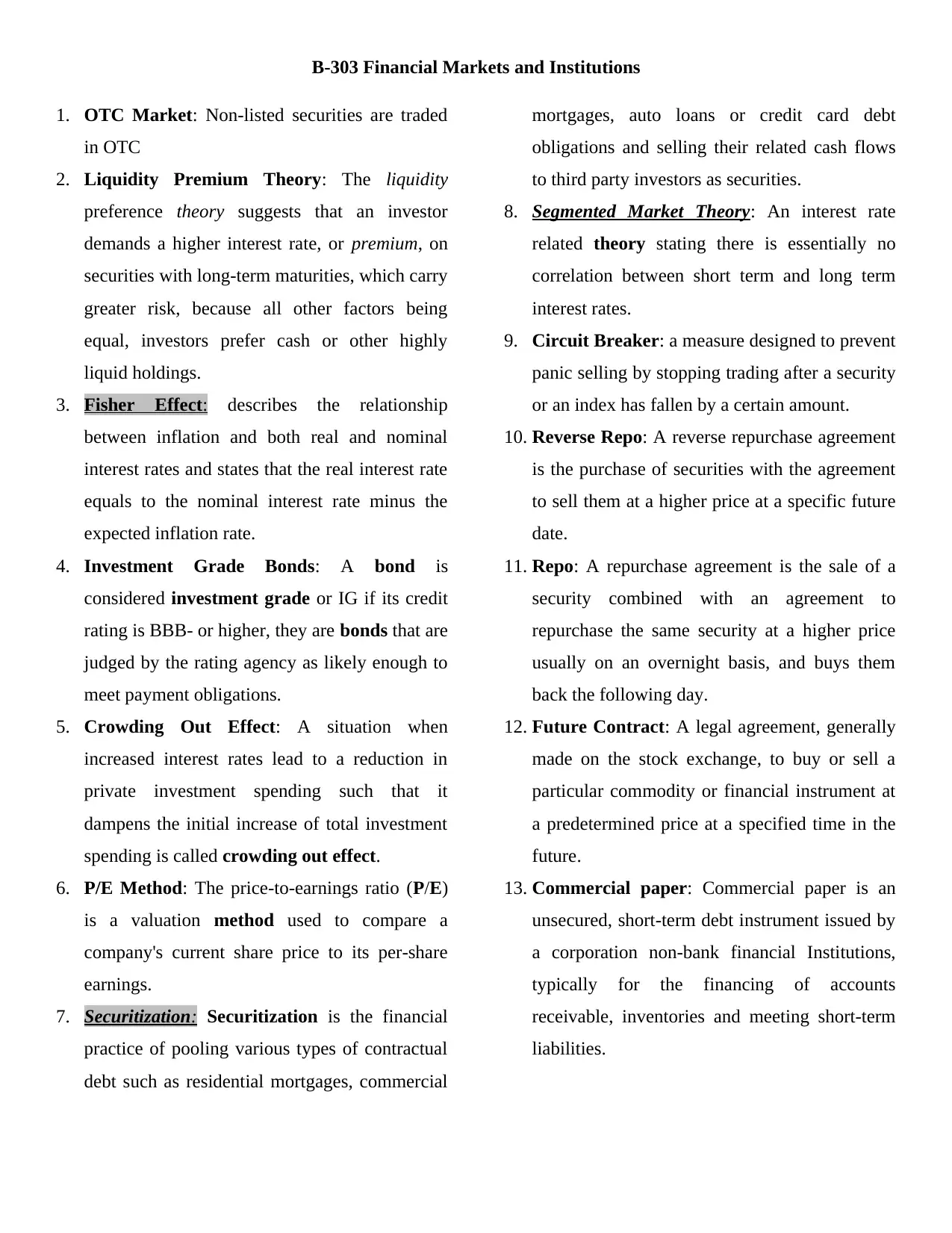
B-303 Financial Markets and Institutions
1. OTC Market: Non-listed securities are traded
in OTC
2. Liquidity Premium Theory: The liquidity
preference theory suggests that an investor
demands a higher interest rate, or premium, on
securities with long-term maturities, which carry
greater risk, because all other factors being
equal, investors prefer cash or other highly
liquid holdings.
3. Fisher Effect: describes the relationship
between inflation and both real and nominal
interest rates and states that the real interest rate
equals to the nominal interest rate minus the
expected inflation rate.
4. Investment Grade Bonds: A bond is
considered investment grade or IG if its credit
rating is BBB- or higher, they are bonds that are
judged by the rating agency as likely enough to
meet payment obligations.
5. Crowding Out Effect: A situation when
increased interest rates lead to a reduction in
private investment spending such that it
dampens the initial increase of total investment
spending is called crowding out effect.
6. P/E Method: The price-to-earnings ratio (P/E)
is a valuation method used to compare a
company's current share price to its per-share
earnings.
7. Securitization: Securitization is the financial
practice of pooling various types of contractual
debt such as residential mortgages, commercial
mortgages, auto loans or credit card debt
obligations and selling their related cash flows
to third party investors as securities.
8. Segmented Market Theory: An interest rate
related theory stating there is essentially no
correlation between short term and long term
interest rates.
9. Circuit Breaker: a measure designed to prevent
panic selling by stopping trading after a security
or an index has fallen by a certain amount.
10. Reverse Repo: A reverse repurchase agreement
is the purchase of securities with the agreement
to sell them at a higher price at a specific future
date.
11. Repo: A repurchase agreement is the sale of a
security combined with an agreement to
repurchase the same security at a higher price
usually on an overnight basis, and buys them
back the following day.
12. Future Contract: A legal agreement, generally
made on the stock exchange, to buy or sell a
particular commodity or financial instrument at
a predetermined price at a specified time in the
future.
13. Commercial paper: Commercial paper is an
unsecured, short-term debt instrument issued by
a corporation non-bank financial Institutions,
typically for the financing of accounts
receivable, inventories and meeting short-term
liabilities.
1. OTC Market: Non-listed securities are traded
in OTC
2. Liquidity Premium Theory: The liquidity
preference theory suggests that an investor
demands a higher interest rate, or premium, on
securities with long-term maturities, which carry
greater risk, because all other factors being
equal, investors prefer cash or other highly
liquid holdings.
3. Fisher Effect: describes the relationship
between inflation and both real and nominal
interest rates and states that the real interest rate
equals to the nominal interest rate minus the
expected inflation rate.
4. Investment Grade Bonds: A bond is
considered investment grade or IG if its credit
rating is BBB- or higher, they are bonds that are
judged by the rating agency as likely enough to
meet payment obligations.
5. Crowding Out Effect: A situation when
increased interest rates lead to a reduction in
private investment spending such that it
dampens the initial increase of total investment
spending is called crowding out effect.
6. P/E Method: The price-to-earnings ratio (P/E)
is a valuation method used to compare a
company's current share price to its per-share
earnings.
7. Securitization: Securitization is the financial
practice of pooling various types of contractual
debt such as residential mortgages, commercial
mortgages, auto loans or credit card debt
obligations and selling their related cash flows
to third party investors as securities.
8. Segmented Market Theory: An interest rate
related theory stating there is essentially no
correlation between short term and long term
interest rates.
9. Circuit Breaker: a measure designed to prevent
panic selling by stopping trading after a security
or an index has fallen by a certain amount.
10. Reverse Repo: A reverse repurchase agreement
is the purchase of securities with the agreement
to sell them at a higher price at a specific future
date.
11. Repo: A repurchase agreement is the sale of a
security combined with an agreement to
repurchase the same security at a higher price
usually on an overnight basis, and buys them
back the following day.
12. Future Contract: A legal agreement, generally
made on the stock exchange, to buy or sell a
particular commodity or financial instrument at
a predetermined price at a specified time in the
future.
13. Commercial paper: Commercial paper is an
unsecured, short-term debt instrument issued by
a corporation non-bank financial Institutions,
typically for the financing of accounts
receivable, inventories and meeting short-term
liabilities.
Paraphrase This Document
Need a fresh take? Get an instant paraphrase of this document with our AI Paraphraser

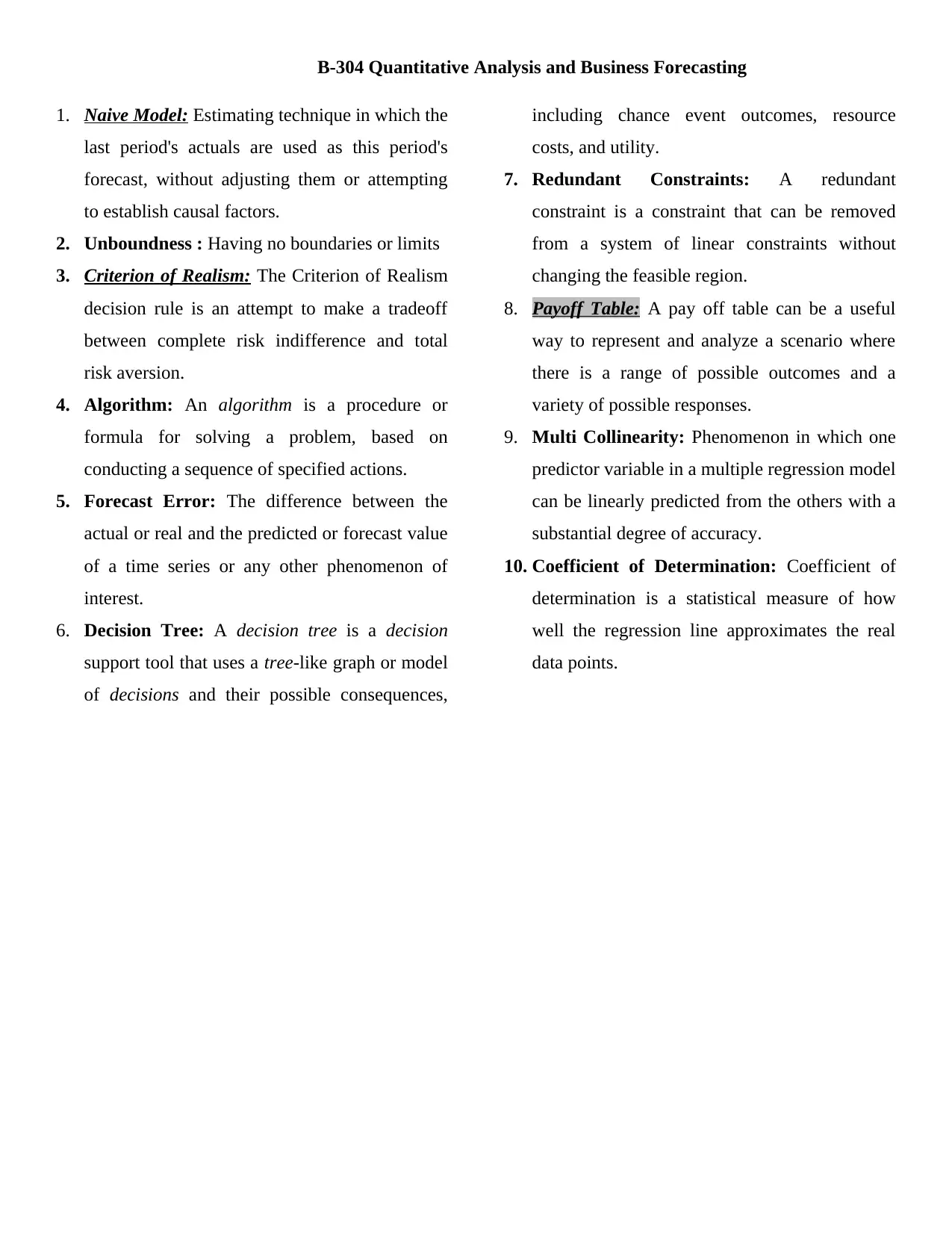
B-304 Quantitative Analysis and Business Forecasting
1. Naive Model: Estimating technique in which the
last period's actuals are used as this period's
forecast, without adjusting them or attempting
to establish causal factors.
2. Unboundness : Having no boundaries or limits
3. Criterion of Realism: The Criterion of Realism
decision rule is an attempt to make a tradeoff
between complete risk indifference and total
risk aversion.
4. Algorithm: An algorithm is a procedure or
formula for solving a problem, based on
conducting a sequence of specified actions.
5. Forecast Error: The difference between the
actual or real and the predicted or forecast value
of a time series or any other phenomenon of
interest.
6. Decision Tree: A decision tree is a decision
support tool that uses a tree-like graph or model
of decisions and their possible consequences,
including chance event outcomes, resource
costs, and utility.
7. Redundant Constraints: A redundant
constraint is a constraint that can be removed
from a system of linear constraints without
changing the feasible region.
8. Payoff Table: A pay off table can be a useful
way to represent and analyze a scenario where
there is a range of possible outcomes and a
variety of possible responses.
9. Multi Collinearity: Phenomenon in which one
predictor variable in a multiple regression model
can be linearly predicted from the others with a
substantial degree of accuracy.
10. Coefficient of Determination: Coefficient of
determination is a statistical measure of how
well the regression line approximates the real
data points.
1. Naive Model: Estimating technique in which the
last period's actuals are used as this period's
forecast, without adjusting them or attempting
to establish causal factors.
2. Unboundness : Having no boundaries or limits
3. Criterion of Realism: The Criterion of Realism
decision rule is an attempt to make a tradeoff
between complete risk indifference and total
risk aversion.
4. Algorithm: An algorithm is a procedure or
formula for solving a problem, based on
conducting a sequence of specified actions.
5. Forecast Error: The difference between the
actual or real and the predicted or forecast value
of a time series or any other phenomenon of
interest.
6. Decision Tree: A decision tree is a decision
support tool that uses a tree-like graph or model
of decisions and their possible consequences,
including chance event outcomes, resource
costs, and utility.
7. Redundant Constraints: A redundant
constraint is a constraint that can be removed
from a system of linear constraints without
changing the feasible region.
8. Payoff Table: A pay off table can be a useful
way to represent and analyze a scenario where
there is a range of possible outcomes and a
variety of possible responses.
9. Multi Collinearity: Phenomenon in which one
predictor variable in a multiple regression model
can be linearly predicted from the others with a
substantial degree of accuracy.
10. Coefficient of Determination: Coefficient of
determination is a statistical measure of how
well the regression line approximates the real
data points.
⊘ This is a preview!⊘
Do you want full access?
Subscribe today to unlock all pages.

Trusted by 1+ million students worldwide
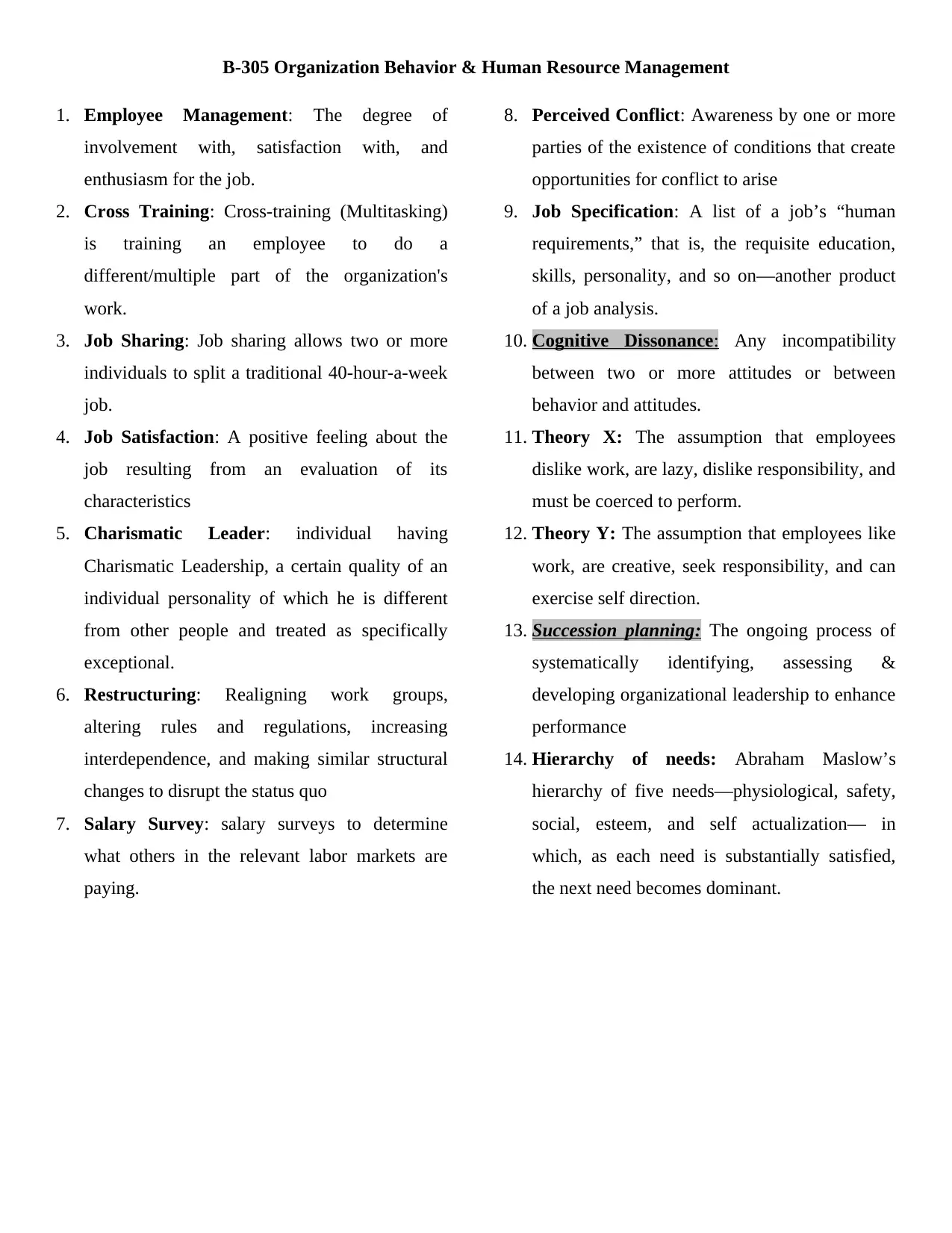
B-305 Organization Behavior & Human Resource Management
1. Employee Management: The degree of
involvement with, satisfaction with, and
enthusiasm for the job.
2. Cross Training: Cross-training (Multitasking)
is training an employee to do a
different/multiple part of the organization's
work.
3. Job Sharing: Job sharing allows two or more
individuals to split a traditional 40-hour-a-week
job.
4. Job Satisfaction: A positive feeling about the
job resulting from an evaluation of its
characteristics
5. Charismatic Leader: individual having
Charismatic Leadership, a certain quality of an
individual personality of which he is different
from other people and treated as specifically
exceptional.
6. Restructuring: Realigning work groups,
altering rules and regulations, increasing
interdependence, and making similar structural
changes to disrupt the status quo
7. Salary Survey: salary surveys to determine
what others in the relevant labor markets are
paying.
8. Perceived Conflict: Awareness by one or more
parties of the existence of conditions that create
opportunities for conflict to arise
9. Job Specification: A list of a job’s “human
requirements,” that is, the requisite education,
skills, personality, and so on—another product
of a job analysis.
10. Cognitive Dissonance: Any incompatibility
between two or more attitudes or between
behavior and attitudes.
11. Theory X: The assumption that employees
dislike work, are lazy, dislike responsibility, and
must be coerced to perform.
12. Theory Y: The assumption that employees like
work, are creative, seek responsibility, and can
exercise self direction.
13. Succession planning: The ongoing process of
systematically identifying, assessing &
developing organizational leadership to enhance
performance
14. Hierarchy of needs: Abraham Maslow’s
hierarchy of five needs—physiological, safety,
social, esteem, and self actualization— in
which, as each need is substantially satisfied,
the next need becomes dominant.
1. Employee Management: The degree of
involvement with, satisfaction with, and
enthusiasm for the job.
2. Cross Training: Cross-training (Multitasking)
is training an employee to do a
different/multiple part of the organization's
work.
3. Job Sharing: Job sharing allows two or more
individuals to split a traditional 40-hour-a-week
job.
4. Job Satisfaction: A positive feeling about the
job resulting from an evaluation of its
characteristics
5. Charismatic Leader: individual having
Charismatic Leadership, a certain quality of an
individual personality of which he is different
from other people and treated as specifically
exceptional.
6. Restructuring: Realigning work groups,
altering rules and regulations, increasing
interdependence, and making similar structural
changes to disrupt the status quo
7. Salary Survey: salary surveys to determine
what others in the relevant labor markets are
paying.
8. Perceived Conflict: Awareness by one or more
parties of the existence of conditions that create
opportunities for conflict to arise
9. Job Specification: A list of a job’s “human
requirements,” that is, the requisite education,
skills, personality, and so on—another product
of a job analysis.
10. Cognitive Dissonance: Any incompatibility
between two or more attitudes or between
behavior and attitudes.
11. Theory X: The assumption that employees
dislike work, are lazy, dislike responsibility, and
must be coerced to perform.
12. Theory Y: The assumption that employees like
work, are creative, seek responsibility, and can
exercise self direction.
13. Succession planning: The ongoing process of
systematically identifying, assessing &
developing organizational leadership to enhance
performance
14. Hierarchy of needs: Abraham Maslow’s
hierarchy of five needs—physiological, safety,
social, esteem, and self actualization— in
which, as each need is substantially satisfied,
the next need becomes dominant.
Paraphrase This Document
Need a fresh take? Get an instant paraphrase of this document with our AI Paraphraser
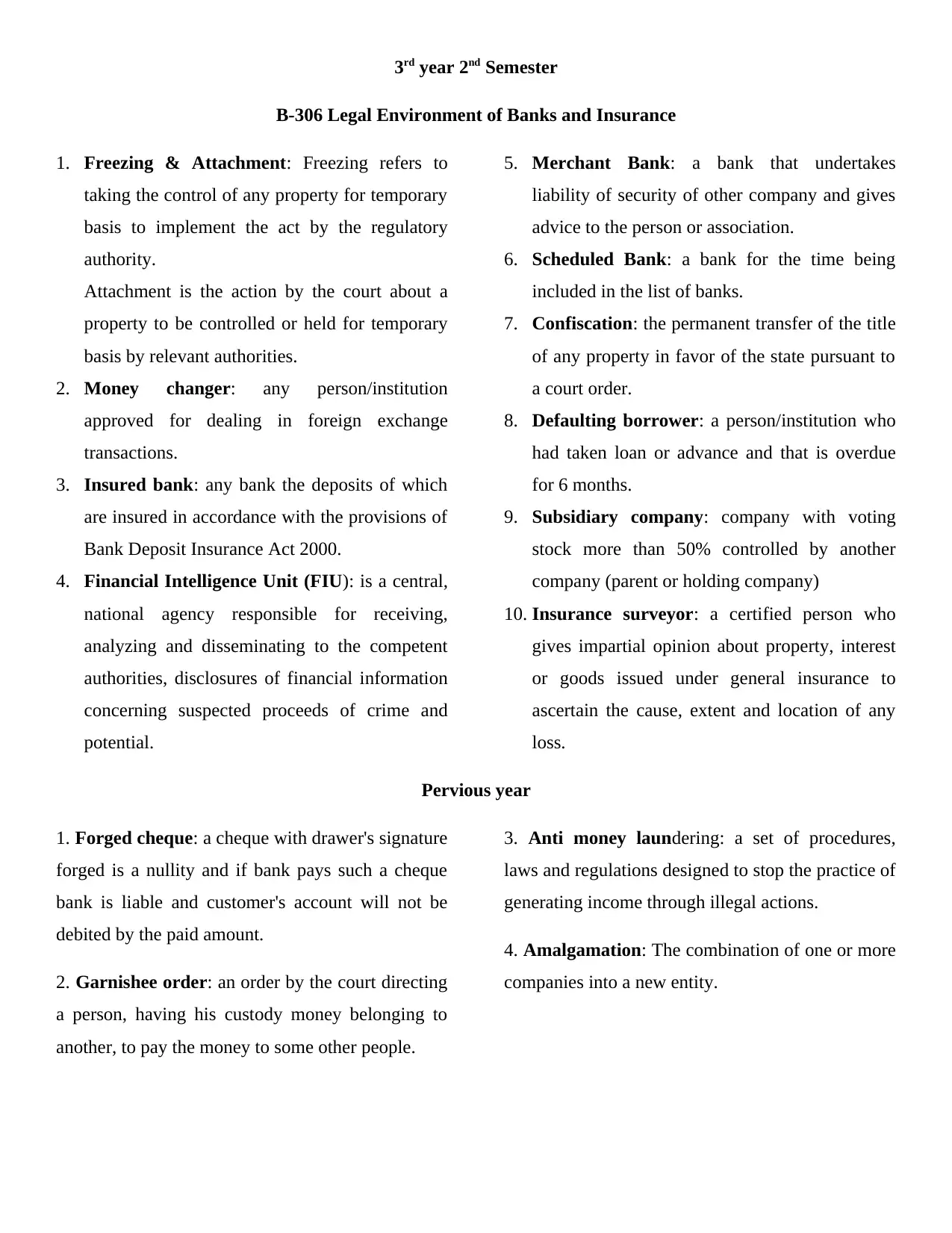
3rd year 2nd Semester
B-306 Legal Environment of Banks and Insurance
1. Freezing & Attachment: Freezing refers to
taking the control of any property for temporary
basis to implement the act by the regulatory
authority.
Attachment is the action by the court about a
property to be controlled or held for temporary
basis by relevant authorities.
2. Money changer: any person/institution
approved for dealing in foreign exchange
transactions.
3. Insured bank: any bank the deposits of which
are insured in accordance with the provisions of
Bank Deposit Insurance Act 2000.
4. Financial Intelligence Unit (FIU): is a central,
national agency responsible for receiving,
analyzing and disseminating to the competent
authorities, disclosures of financial information
concerning suspected proceeds of crime and
potential.
5. Merchant Bank: a bank that undertakes
liability of security of other company and gives
advice to the person or association.
6. Scheduled Bank: a bank for the time being
included in the list of banks.
7. Confiscation: the permanent transfer of the title
of any property in favor of the state pursuant to
a court order.
8. Defaulting borrower: a person/institution who
had taken loan or advance and that is overdue
for 6 months.
9. Subsidiary company: company with voting
stock more than 50% controlled by another
company (parent or holding company)
10. Insurance surveyor: a certified person who
gives impartial opinion about property, interest
or goods issued under general insurance to
ascertain the cause, extent and location of any
loss.
Pervious year
1. Forged cheque: a cheque with drawer's signature
forged is a nullity and if bank pays such a cheque
bank is liable and customer's account will not be
debited by the paid amount.
2. Garnishee order: an order by the court directing
a person, having his custody money belonging to
another, to pay the money to some other people.
3. Anti money laundering: a set of procedures,
laws and regulations designed to stop the practice of
generating income through illegal actions.
4. Amalgamation: The combination of one or more
companies into a new entity.
B-306 Legal Environment of Banks and Insurance
1. Freezing & Attachment: Freezing refers to
taking the control of any property for temporary
basis to implement the act by the regulatory
authority.
Attachment is the action by the court about a
property to be controlled or held for temporary
basis by relevant authorities.
2. Money changer: any person/institution
approved for dealing in foreign exchange
transactions.
3. Insured bank: any bank the deposits of which
are insured in accordance with the provisions of
Bank Deposit Insurance Act 2000.
4. Financial Intelligence Unit (FIU): is a central,
national agency responsible for receiving,
analyzing and disseminating to the competent
authorities, disclosures of financial information
concerning suspected proceeds of crime and
potential.
5. Merchant Bank: a bank that undertakes
liability of security of other company and gives
advice to the person or association.
6. Scheduled Bank: a bank for the time being
included in the list of banks.
7. Confiscation: the permanent transfer of the title
of any property in favor of the state pursuant to
a court order.
8. Defaulting borrower: a person/institution who
had taken loan or advance and that is overdue
for 6 months.
9. Subsidiary company: company with voting
stock more than 50% controlled by another
company (parent or holding company)
10. Insurance surveyor: a certified person who
gives impartial opinion about property, interest
or goods issued under general insurance to
ascertain the cause, extent and location of any
loss.
Pervious year
1. Forged cheque: a cheque with drawer's signature
forged is a nullity and if bank pays such a cheque
bank is liable and customer's account will not be
debited by the paid amount.
2. Garnishee order: an order by the court directing
a person, having his custody money belonging to
another, to pay the money to some other people.
3. Anti money laundering: a set of procedures,
laws and regulations designed to stop the practice of
generating income through illegal actions.
4. Amalgamation: The combination of one or more
companies into a new entity.
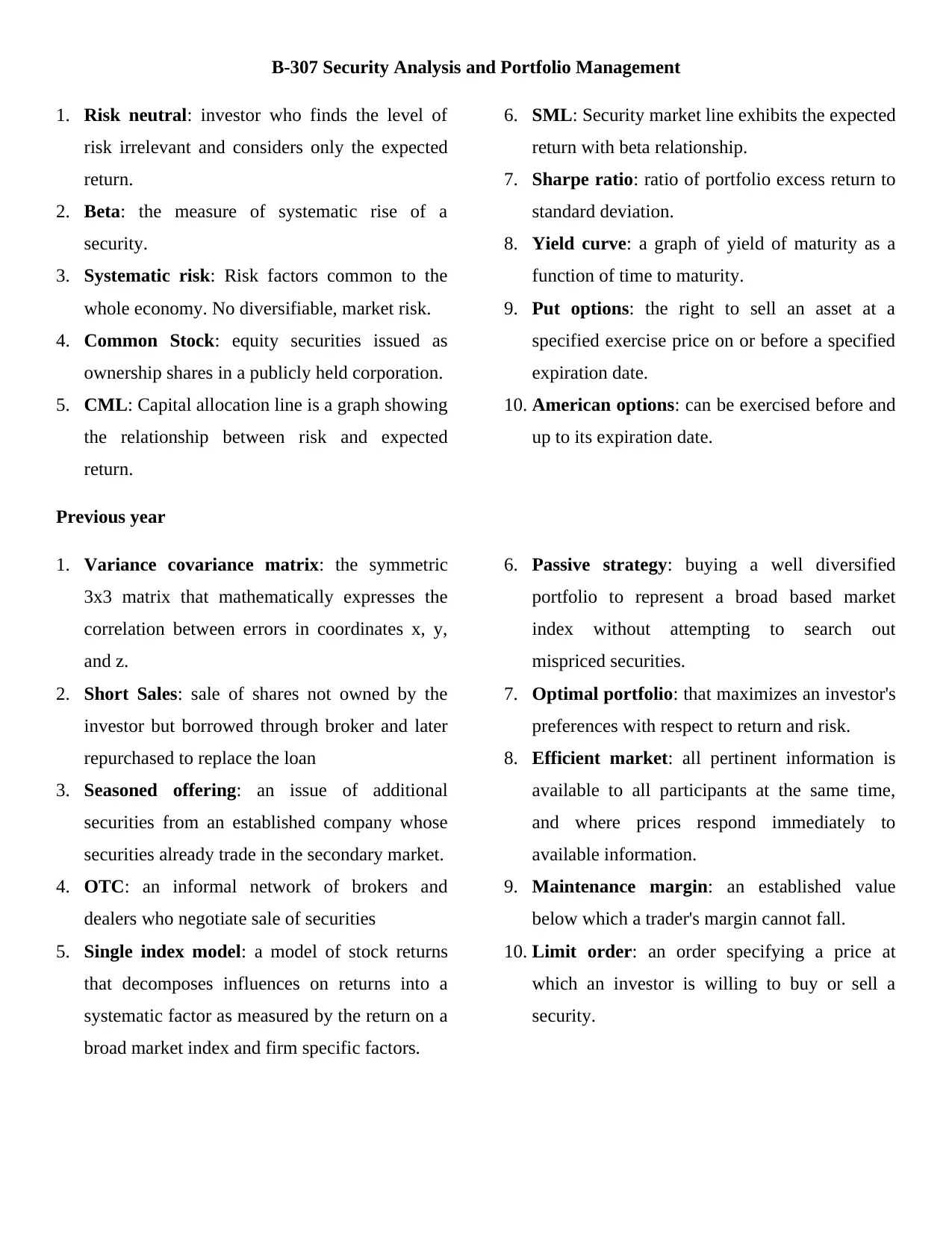
B-307 Security Analysis and Portfolio Management
1. Risk neutral: investor who finds the level of
risk irrelevant and considers only the expected
return.
2. Beta: the measure of systematic rise of a
security.
3. Systematic risk: Risk factors common to the
whole economy. No diversifiable, market risk.
4. Common Stock: equity securities issued as
ownership shares in a publicly held corporation.
5. CML: Capital allocation line is a graph showing
the relationship between risk and expected
return.
6. SML: Security market line exhibits the expected
return with beta relationship.
7. Sharpe ratio: ratio of portfolio excess return to
standard deviation.
8. Yield curve: a graph of yield of maturity as a
function of time to maturity.
9. Put options: the right to sell an asset at a
specified exercise price on or before a specified
expiration date.
10. American options: can be exercised before and
up to its expiration date.
Previous year
1. Variance covariance matrix: the symmetric
3x3 matrix that mathematically expresses the
correlation between errors in coordinates x, y,
and z.
2. Short Sales: sale of shares not owned by the
investor but borrowed through broker and later
repurchased to replace the loan
3. Seasoned offering: an issue of additional
securities from an established company whose
securities already trade in the secondary market.
4. OTC: an informal network of brokers and
dealers who negotiate sale of securities
5. Single index model: a model of stock returns
that decomposes influences on returns into a
systematic factor as measured by the return on a
broad market index and firm specific factors.
6. Passive strategy: buying a well diversified
portfolio to represent a broad based market
index without attempting to search out
mispriced securities.
7. Optimal portfolio: that maximizes an investor's
preferences with respect to return and risk.
8. Efficient market: all pertinent information is
available to all participants at the same time,
and where prices respond immediately to
available information.
9. Maintenance margin: an established value
below which a trader's margin cannot fall.
10. Limit order: an order specifying a price at
which an investor is willing to buy or sell a
security.
1. Risk neutral: investor who finds the level of
risk irrelevant and considers only the expected
return.
2. Beta: the measure of systematic rise of a
security.
3. Systematic risk: Risk factors common to the
whole economy. No diversifiable, market risk.
4. Common Stock: equity securities issued as
ownership shares in a publicly held corporation.
5. CML: Capital allocation line is a graph showing
the relationship between risk and expected
return.
6. SML: Security market line exhibits the expected
return with beta relationship.
7. Sharpe ratio: ratio of portfolio excess return to
standard deviation.
8. Yield curve: a graph of yield of maturity as a
function of time to maturity.
9. Put options: the right to sell an asset at a
specified exercise price on or before a specified
expiration date.
10. American options: can be exercised before and
up to its expiration date.
Previous year
1. Variance covariance matrix: the symmetric
3x3 matrix that mathematically expresses the
correlation between errors in coordinates x, y,
and z.
2. Short Sales: sale of shares not owned by the
investor but borrowed through broker and later
repurchased to replace the loan
3. Seasoned offering: an issue of additional
securities from an established company whose
securities already trade in the secondary market.
4. OTC: an informal network of brokers and
dealers who negotiate sale of securities
5. Single index model: a model of stock returns
that decomposes influences on returns into a
systematic factor as measured by the return on a
broad market index and firm specific factors.
6. Passive strategy: buying a well diversified
portfolio to represent a broad based market
index without attempting to search out
mispriced securities.
7. Optimal portfolio: that maximizes an investor's
preferences with respect to return and risk.
8. Efficient market: all pertinent information is
available to all participants at the same time,
and where prices respond immediately to
available information.
9. Maintenance margin: an established value
below which a trader's margin cannot fall.
10. Limit order: an order specifying a price at
which an investor is willing to buy or sell a
security.
⊘ This is a preview!⊘
Do you want full access?
Subscribe today to unlock all pages.

Trusted by 1+ million students worldwide
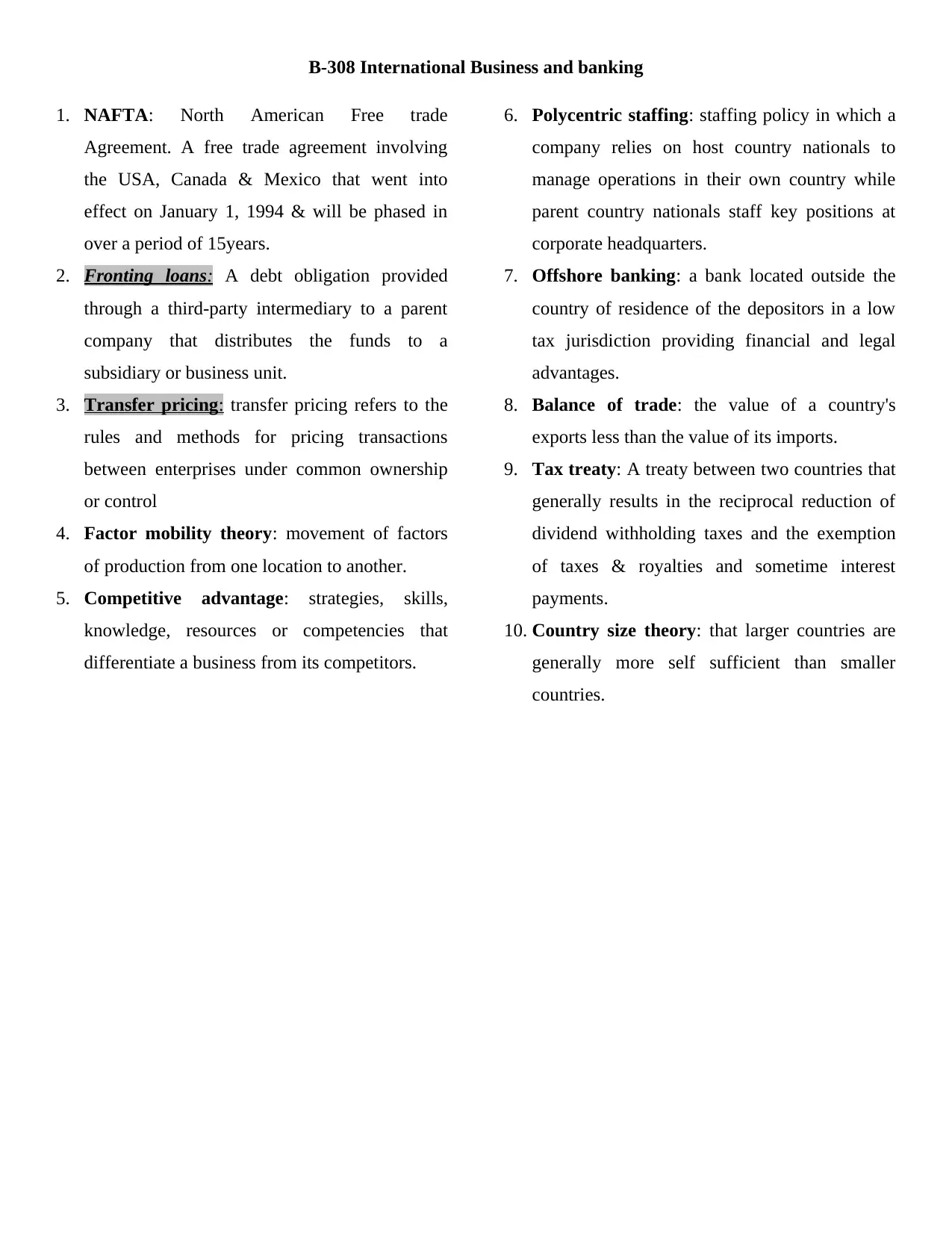
B-308 International Business and banking
1. NAFTA: North American Free trade
Agreement. A free trade agreement involving
the USA, Canada & Mexico that went into
effect on January 1, 1994 & will be phased in
over a period of 15years.
2. Fronting loans: A debt obligation provided
through a third-party intermediary to a parent
company that distributes the funds to a
subsidiary or business unit.
3. Transfer pricing: transfer pricing refers to the
rules and methods for pricing transactions
between enterprises under common ownership
or control
4. Factor mobility theory: movement of factors
of production from one location to another.
5. Competitive advantage: strategies, skills,
knowledge, resources or competencies that
differentiate a business from its competitors.
6. Polycentric staffing: staffing policy in which a
company relies on host country nationals to
manage operations in their own country while
parent country nationals staff key positions at
corporate headquarters.
7. Offshore banking: a bank located outside the
country of residence of the depositors in a low
tax jurisdiction providing financial and legal
advantages.
8. Balance of trade: the value of a country's
exports less than the value of its imports.
9. Tax treaty: A treaty between two countries that
generally results in the reciprocal reduction of
dividend withholding taxes and the exemption
of taxes & royalties and sometime interest
payments.
10. Country size theory: that larger countries are
generally more self sufficient than smaller
countries.
1. NAFTA: North American Free trade
Agreement. A free trade agreement involving
the USA, Canada & Mexico that went into
effect on January 1, 1994 & will be phased in
over a period of 15years.
2. Fronting loans: A debt obligation provided
through a third-party intermediary to a parent
company that distributes the funds to a
subsidiary or business unit.
3. Transfer pricing: transfer pricing refers to the
rules and methods for pricing transactions
between enterprises under common ownership
or control
4. Factor mobility theory: movement of factors
of production from one location to another.
5. Competitive advantage: strategies, skills,
knowledge, resources or competencies that
differentiate a business from its competitors.
6. Polycentric staffing: staffing policy in which a
company relies on host country nationals to
manage operations in their own country while
parent country nationals staff key positions at
corporate headquarters.
7. Offshore banking: a bank located outside the
country of residence of the depositors in a low
tax jurisdiction providing financial and legal
advantages.
8. Balance of trade: the value of a country's
exports less than the value of its imports.
9. Tax treaty: A treaty between two countries that
generally results in the reciprocal reduction of
dividend withholding taxes and the exemption
of taxes & royalties and sometime interest
payments.
10. Country size theory: that larger countries are
generally more self sufficient than smaller
countries.
Paraphrase This Document
Need a fresh take? Get an instant paraphrase of this document with our AI Paraphraser
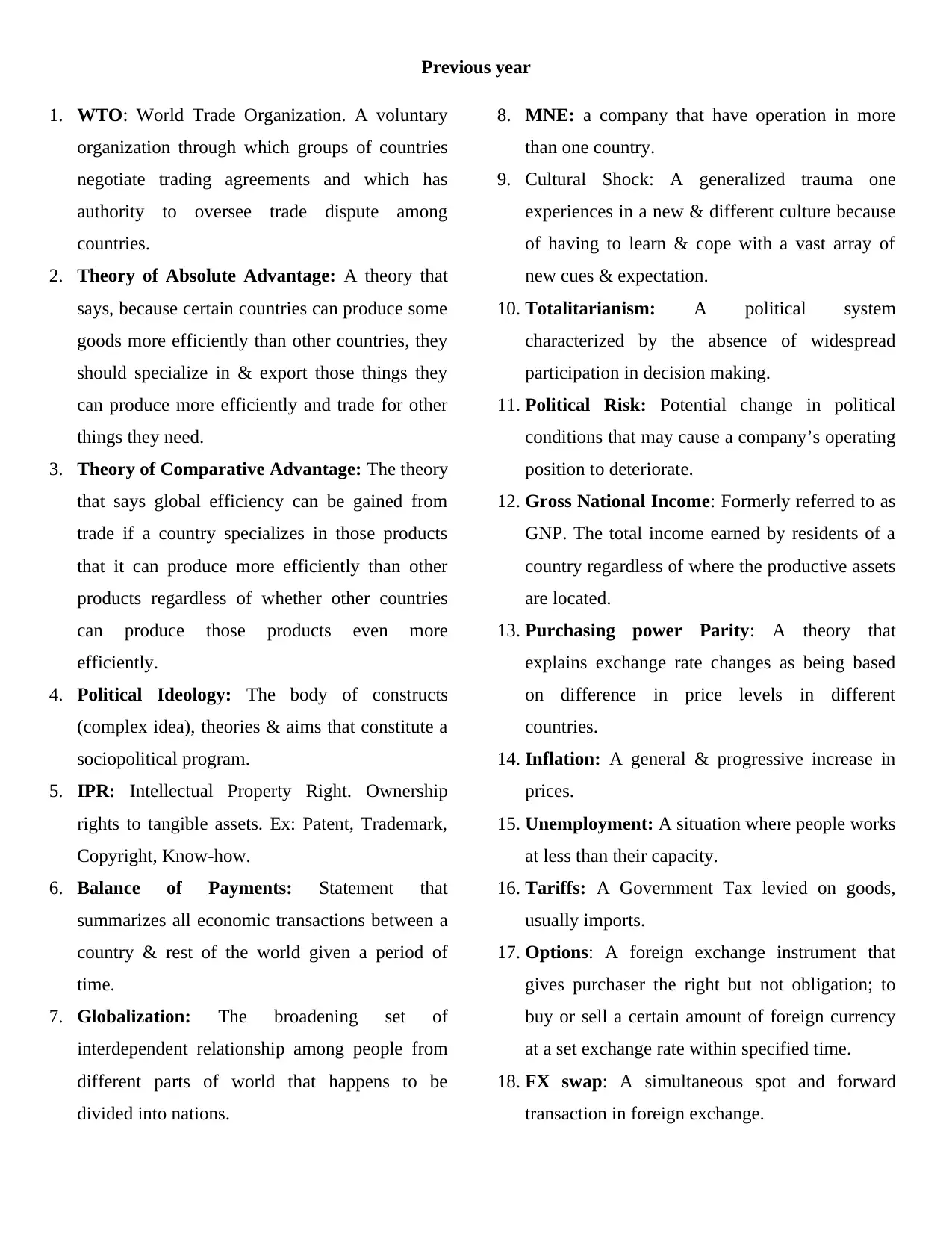
Previous year
1. WTO: World Trade Organization. A voluntary
organization through which groups of countries
negotiate trading agreements and which has
authority to oversee trade dispute among
countries.
2. Theory of Absolute Advantage: A theory that
says, because certain countries can produce some
goods more efficiently than other countries, they
should specialize in & export those things they
can produce more efficiently and trade for other
things they need.
3. Theory of Comparative Advantage: The theory
that says global efficiency can be gained from
trade if a country specializes in those products
that it can produce more efficiently than other
products regardless of whether other countries
can produce those products even more
efficiently.
4. Political Ideology: The body of constructs
(complex idea), theories & aims that constitute a
sociopolitical program.
5. IPR: Intellectual Property Right. Ownership
rights to tangible assets. Ex: Patent, Trademark,
Copyright, Know-how.
6. Balance of Payments: Statement that
summarizes all economic transactions between a
country & rest of the world given a period of
time.
7. Globalization: The broadening set of
interdependent relationship among people from
different parts of world that happens to be
divided into nations.
8. MNE: a company that have operation in more
than one country.
9. Cultural Shock: A generalized trauma one
experiences in a new & different culture because
of having to learn & cope with a vast array of
new cues & expectation.
10. Totalitarianism: A political system
characterized by the absence of widespread
participation in decision making.
11. Political Risk: Potential change in political
conditions that may cause a company’s operating
position to deteriorate.
12. Gross National Income: Formerly referred to as
GNP. The total income earned by residents of a
country regardless of where the productive assets
are located.
13. Purchasing power Parity: A theory that
explains exchange rate changes as being based
on difference in price levels in different
countries.
14. Inflation: A general & progressive increase in
prices.
15. Unemployment: A situation where people works
at less than their capacity.
16. Tariffs: A Government Tax levied on goods,
usually imports.
17. Options: A foreign exchange instrument that
gives purchaser the right but not obligation; to
buy or sell a certain amount of foreign currency
at a set exchange rate within specified time.
18. FX swap: A simultaneous spot and forward
transaction in foreign exchange.
1. WTO: World Trade Organization. A voluntary
organization through which groups of countries
negotiate trading agreements and which has
authority to oversee trade dispute among
countries.
2. Theory of Absolute Advantage: A theory that
says, because certain countries can produce some
goods more efficiently than other countries, they
should specialize in & export those things they
can produce more efficiently and trade for other
things they need.
3. Theory of Comparative Advantage: The theory
that says global efficiency can be gained from
trade if a country specializes in those products
that it can produce more efficiently than other
products regardless of whether other countries
can produce those products even more
efficiently.
4. Political Ideology: The body of constructs
(complex idea), theories & aims that constitute a
sociopolitical program.
5. IPR: Intellectual Property Right. Ownership
rights to tangible assets. Ex: Patent, Trademark,
Copyright, Know-how.
6. Balance of Payments: Statement that
summarizes all economic transactions between a
country & rest of the world given a period of
time.
7. Globalization: The broadening set of
interdependent relationship among people from
different parts of world that happens to be
divided into nations.
8. MNE: a company that have operation in more
than one country.
9. Cultural Shock: A generalized trauma one
experiences in a new & different culture because
of having to learn & cope with a vast array of
new cues & expectation.
10. Totalitarianism: A political system
characterized by the absence of widespread
participation in decision making.
11. Political Risk: Potential change in political
conditions that may cause a company’s operating
position to deteriorate.
12. Gross National Income: Formerly referred to as
GNP. The total income earned by residents of a
country regardless of where the productive assets
are located.
13. Purchasing power Parity: A theory that
explains exchange rate changes as being based
on difference in price levels in different
countries.
14. Inflation: A general & progressive increase in
prices.
15. Unemployment: A situation where people works
at less than their capacity.
16. Tariffs: A Government Tax levied on goods,
usually imports.
17. Options: A foreign exchange instrument that
gives purchaser the right but not obligation; to
buy or sell a certain amount of foreign currency
at a set exchange rate within specified time.
18. FX swap: A simultaneous spot and forward
transaction in foreign exchange.

19. Eurocurrency: Any currency that is banked
outside of its country of origin.
20. Turnkey Operation: An operation facility that
is constructed under contract and transferred to
the owner when the facility is ready to begin
operations.
21. ASEAN: Association of South East Asian
Nations. A free trade area involving the Asian
countries of Brunei, Indonesia, Malaysia, The
Philippe’s, Singapore, Thailand
22. Exchange Rates: The price of one currency in
terms of another currency.
23. SAARC: The South Asian Association for
Regional Cooperation (SAARC) is the regional
intergovernmental organization and geopolitical
union of nations in South Asia. Its member states
include Afghanistan, Bangladesh, Bhutan, India,
Nepal, the Maldives, Pakistan and Sri Lanka.
24. LIBOR: London Interbank Offer Rate, the
interest rate for large interbank loans of
Eurocurrency.
25. Strategic Alliance: An agreement between
companies that is of strategic importance to one
or both companies’ competitive variability
26. Mercantilism: An economic philosophy based
on the beliefs that a countries wealth is
dependent on its holdings of treasure usually in
the form of gold & that countries should export
more then they import in order to maximize
wealth.
27. Spot Rate: An exchange rate quoted for
immediate delivery of foreign currency, usually
within two business days.
28. Foreign Direct Investment: An investment that
gives the investor a controlling interest in a
foreign company.
29. Franchising: A special form of licensing in
which one party (the franchisor) gives
permission to a independent party ( franchisee)
the use of a trademark that is essential asset for
the franchises business& also gives continuous
assistance in the operation of the business.
30. Infant Industry: Emerging industry in the
economy.
31. Nominal Interest Rate: interest rate before
taking inflation into account
32. Hard Currency: A currency that is freely traded
without many restrictions & for which there is
usually strong external demand also known as
Freely Convertible Currency.
33. IMF: International Monetary Fund. A multi-
governmental association organized in 1945 to
promote exchange rate stability & to facilitate the
international flow of currency.
34. Mixed Economy: An economic system
characterized by mixture of market & command
economies; Balances public & private ownership
of factor of productions.
35. SAFTA: The South Asian Free Trade Area
(SAFTA) is an agreement reached on 6 January
2004 at the 12th SAARC summit in Islamabad,
Pakistan. SAFTA came into effect on 1 January
2006, with the aim of reducing tariffs for
intraregional trade among the seven SAARC
members.
36. Protectionism: Government restrictions on
export & import that frequently give direct or
indirect subsidies to industry to enable them to
outside of its country of origin.
20. Turnkey Operation: An operation facility that
is constructed under contract and transferred to
the owner when the facility is ready to begin
operations.
21. ASEAN: Association of South East Asian
Nations. A free trade area involving the Asian
countries of Brunei, Indonesia, Malaysia, The
Philippe’s, Singapore, Thailand
22. Exchange Rates: The price of one currency in
terms of another currency.
23. SAARC: The South Asian Association for
Regional Cooperation (SAARC) is the regional
intergovernmental organization and geopolitical
union of nations in South Asia. Its member states
include Afghanistan, Bangladesh, Bhutan, India,
Nepal, the Maldives, Pakistan and Sri Lanka.
24. LIBOR: London Interbank Offer Rate, the
interest rate for large interbank loans of
Eurocurrency.
25. Strategic Alliance: An agreement between
companies that is of strategic importance to one
or both companies’ competitive variability
26. Mercantilism: An economic philosophy based
on the beliefs that a countries wealth is
dependent on its holdings of treasure usually in
the form of gold & that countries should export
more then they import in order to maximize
wealth.
27. Spot Rate: An exchange rate quoted for
immediate delivery of foreign currency, usually
within two business days.
28. Foreign Direct Investment: An investment that
gives the investor a controlling interest in a
foreign company.
29. Franchising: A special form of licensing in
which one party (the franchisor) gives
permission to a independent party ( franchisee)
the use of a trademark that is essential asset for
the franchises business& also gives continuous
assistance in the operation of the business.
30. Infant Industry: Emerging industry in the
economy.
31. Nominal Interest Rate: interest rate before
taking inflation into account
32. Hard Currency: A currency that is freely traded
without many restrictions & for which there is
usually strong external demand also known as
Freely Convertible Currency.
33. IMF: International Monetary Fund. A multi-
governmental association organized in 1945 to
promote exchange rate stability & to facilitate the
international flow of currency.
34. Mixed Economy: An economic system
characterized by mixture of market & command
economies; Balances public & private ownership
of factor of productions.
35. SAFTA: The South Asian Free Trade Area
(SAFTA) is an agreement reached on 6 January
2004 at the 12th SAARC summit in Islamabad,
Pakistan. SAFTA came into effect on 1 January
2006, with the aim of reducing tariffs for
intraregional trade among the seven SAARC
members.
36. Protectionism: Government restrictions on
export & import that frequently give direct or
indirect subsidies to industry to enable them to
⊘ This is a preview!⊘
Do you want full access?
Subscribe today to unlock all pages.

Trusted by 1+ million students worldwide
1 out of 16